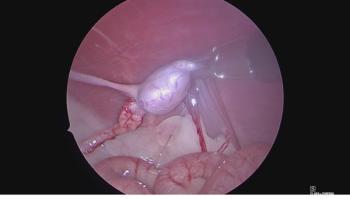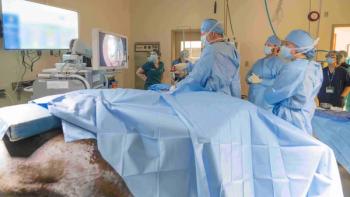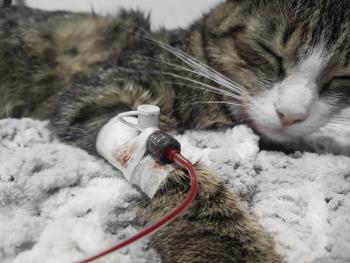
Cribbing in horses: A surgical approach to treatment
Cutting-edge advice for this behavioral vice in your veterinary equine patients.
A horse exhibiting cribbing behavior. (Image from Shutterstock/Thomas Barrat)
Cribbing is a compulsive behavioral disorder in which a horse habitually bites down on a horizontal surface with its incisors and sucks in air, often making a grunting or gulping noise. You know it if you've seen it. In one study of U.S. horses, the overall prevalence of this behavior was 4.4%.1 In that study, Thoroughbreds were the breed most commonly affected at 13.3%.
Dr. Laura RiggsWhy do horses conduct this odd behavior? “It's the same as people having certain vices,” said Laura Riggs, DVM, PhD, DACVS, an associate professor at Louisiana State University's Department of Veterinary Clinical Sciences, at a recent CVC. “Biting your fingernails, little kids sucking on their thumbs-these are all things that cause a response in the brain-decreased cortisol levels, decreased heart rate.”
That's the why. There's a physiologic reward. So which horses are affected? Riggs said this behavior is only seen in domesticated animals, not in wild horses, likely because of horse management practices. “If you look at feral populations of horses that are happy out running around, that don't get put in stalls, that don't get put in pen situations and that are not really manipulated, they just don't do it,” said Riggs. “It is a result of our management of horses-our necessary management of horses because we ride them, we need them to be at our access, we train them for different disciplines. But it does have a detrimental effect on some horses.”
What about horses that you've seen cribbing out in pasture? “Those are likely horses that at some point had a management where they were stalled more often than a horse in the pasture,” said Riggs.
The concern is that cribbing wears down the incisors and is linked to issues of unthriftiness, poor performance, dental issues, gas colic and strangulating lesions such as epiploic foramen entrapment, said Riggs.
How to curb the cribbing? Interventions are available that make the cribbing behavior physically difficult to perform or painful but are often not effective. Some of these interventions have included muzzles, pressure collars made of metal plates or leather, or shock collars. Out of desperation owners have even turned to the questionable practice of placing hog rings between a horse's incisors so that when it does crib the hog rings are pushed up into the horse's gums causing pain.
Medical management in the form of chemical modulators of brain activity, such as the selective serotonin reuptake inhibitor fluoxetine, though more palatable from an animal welfare standpoint, is rarely effective either.
So some owners have turned to surgical intervention to make it impossible for the horse to crib. The most commonly used surgical method is a modified Forssell's procedure.
The original Forssell's procedure involved removing a lot of muscles-myectomy of the sternomandibularis, omohyoideus and sternothyrohoideus. Riggs said this resulted in poor cosmesis and had highly variable results.
The modified Forssell's procedure combines myectomy of much less muscle tissue than the original procedure-along with neurectomy. The omohyoideus and sternothyrohoideus muscle are resected along with the ventral branch of the spinal accessory nerve.
Riggs discussed a version of the modified procedure performed with a veterinary laser that has had positive results with good cosmesis. She participated in a study that looked at the long-term outcome,2 and of 90 horses that were available for follow up, 76 had stopped the cribbing behavior for a year or more-an 84.4% success rate.
But Riggs said that no one method is completely effective; some horses did return to cribbing after a period of time. “What was associated with success was how long that horse had been cribbing. Surgery tends to be a last resort for some of these horses, but in actuality horses that had been cribbing for less than two years, those horses did so much better.”
Riggs said that drains and daily bandage changes are needed postoperatively. The drains can be removed after three to five days. Antibiotics and nonsteroidal anti-inflammatory drugs are also prescribed.
References
1. Albright JD, Mohammed HO, Heleski RC et al. Crib-biting in US horses: Breed predispositions and owner perceptions of aetiology. Equine Vet J 2009;455-458.
2. Baia P, Burba DJ, Riggs LM, et al. Long term outcome after laser assisted modified Forssell's in cribbing horses. Vet Surg 2015;44:156-161.
Newsletter
From exam room tips to practice management insights, get trusted veterinary news delivered straight to your inbox—subscribe to dvm360.




